Recent state and federal laws (Washington State Registered Sex Offender Law in 1990 and Megans's Law in 1996) provided a unique opportunity for the Pierce County Sheriff's department to educate and inform the public concerning sex offenders. In cooperation with Pierce County Geographic Information Systems, Pierce County Sheriff developed two web applications to comply with these laws and empower local communities. The Registered Sex/Kidnapping Offender Search site (SO) is a web application that allows the public to search their neighborhood for registered sex offenders. The Sex Offender Verification (SOV) web application is used by the Pierce County Sheriff department to verify the addresses of convicted sex offenders and to track the progress of this process with a suite of management reports. These web applications use Esri's MapObjects and ArcIMS and Macromedia's Cold Fusion. Combined these systems allow the Pierce County Sheriff to provide up to date critical public safety information.
Ask any parent and he or she will emphatically tell you that a primary public safety concern is knowing if sex offenders live nearby. The 1990 Washington State Registered Sex Offender Law, known as Megan's Law, requires sex offenders to register their addresses with local law enforcement. The law was later amended to include kidnapping offenders in the registration program (1997). Since the law was enacted, over 2,100 convicted sex/kidnapping offenders have registered in Pierce County. In accordance with the law, the Pierce County Sheriff's Department is required to maintain the registration information for the convicted offenders living in the entire Pierce County area. Local law enforcement agencies in cities within Pierce County are responsible for making sure the offenders living in those jurisdictions are residing at the addresses they reported on their registration forms. The Pierce County Sheriff is also required to verify the address of all sex offenders once a year. The Sex/Kidnapping Offender Registration Law allows the Sheriff's Department to provide information about the location of sex offenders to citizens of Pierce County. The Pierce County Sheriff has limited resources to respond to citizen questions. To determine if an offender lives near a citizen, an officer would have to review a list of over 2,100 individuals and addresses. Combining the latest Internet and Geographic Information System (GIS) technology, Pierce County, has developed a web site that allows citizens to view, query and search information about sex offenders in their neighborhoods. The Sheriff's Crime Analysis Unit and Sex Offender Registry Unit partnered with the GIS Division and a citizens advisory board to create an innovative and simple web site containing this important information. As an extension to this application, the same groups worked together to further expand the limited resources of the Pierce County Sheriff Sex Offender unit and to keep the Sex Offender Registry current. With all of the tips pouring in from the Public Sex Offender site, the Sheriff's Sex Offender Unit and the GIS Division created the Sex Offender Verification Web Application to facilitate this verification process.
Pierce County's Sex Offender Web site was developed with ColdFusion, Esri's Internet Map Server and HTML and can be viewed at www.co.pierce.wa.us/sheriff. To use the site the visitor:
The neighborhood search provides a list of all registered sex/kidnapping offenders within an approximate half-mile radius of the entered address. Users are shown an address-input page where they fill in as much or as little of the address they know.
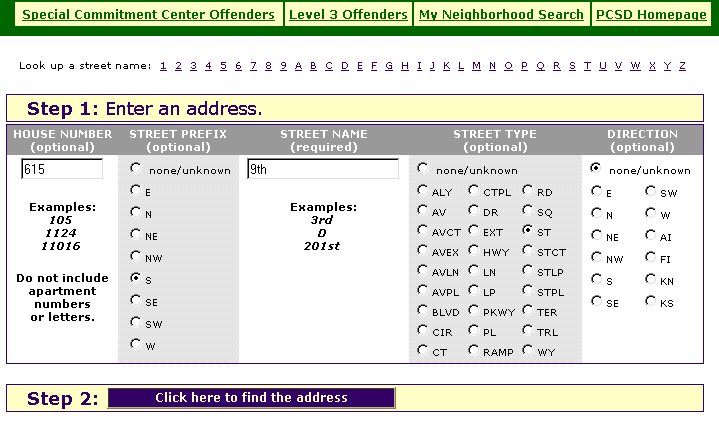
The visitor's address input is sent to the GIS geo-coding program on the Web server. If the user does not know the exact street name he or she has the option of looking up the street name. Using the "look up a street name function" the visitor clicks on the first letter of the street name. The server queries the GIS Street layer and returns a list of all the street names that begin with that letter. This "drill-down" method is popular with visitors because it eliminates frustrating "address not found" errors.
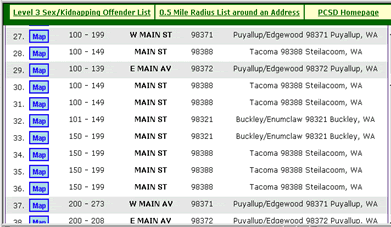
Once the user selects the "Map" button next to their address, the application locates the midpoint of the street segment and displays a map of the area. Next, a GIS operation of point-in-polygon is performed on a data set containing the actual location of sex offenders and a half-mile polygon around the address. The visitor does not view the sex offender locations, only the shaded polygon. The half-mile polygon is created on the fly using a random buffer of +/- 10%. The resulting half-mile polygon has a radius of anywhere between 0.45 and 0.55 miles. The reason for using the street segment mid-point and the random buffer is to prevent visitors from determining the exact location of a given offender. The map server does not allow panning or zooming. The center point of the radius can only be a mid-point segment of one of the 57,000 streets in Pierce County. This buffering method greatly reduces the user's ability to do trial-and-error triangulation to find the exact address of a given offender. All of these actions prevent vigilante activity.
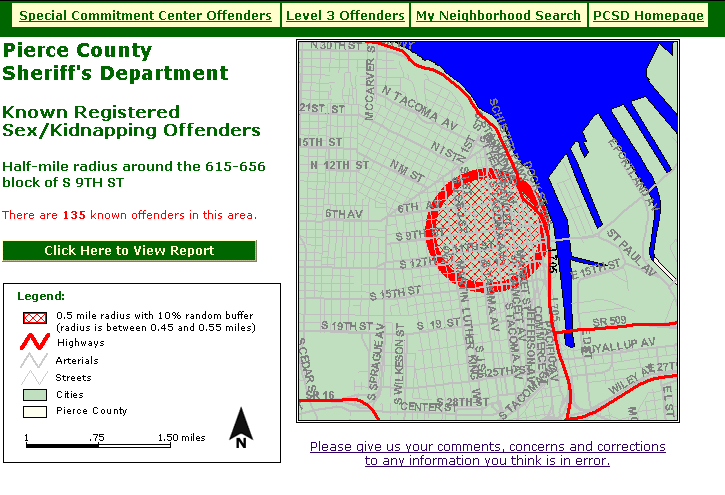
Below the map, a report lists the name, level, sex, age and crime of all offenders in the area. The age is displayed using an on-the-fly calculation using the current date and the date of birth of the offender.
A few (less than 1%) of the offenders are listed a "Level 3", most likely to re-offend. For these offenders a link is provided to a pop-up window with additional details about their crime and a photograph. To discourage visitors from copying the photos to create "wanted" posters, the right mouse button's "copy" function is disabled.
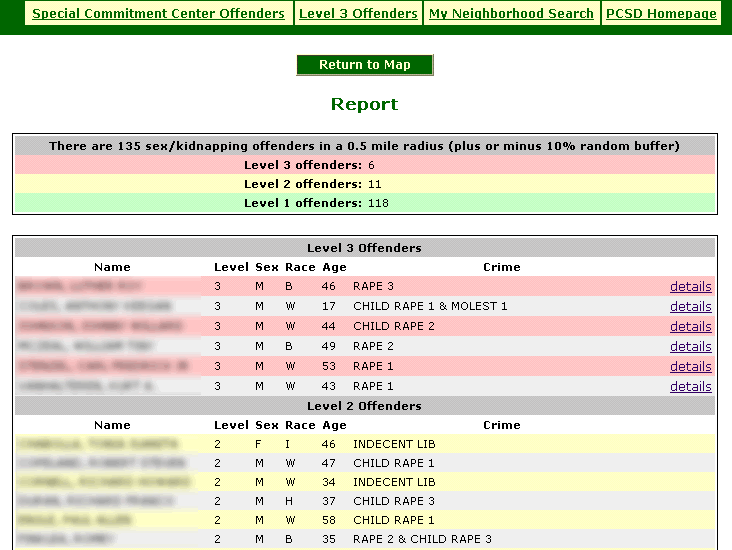
The second search function is related only to "Level Three" offenders. This search produces a list of the "Level Three" offenders. State law allows the Sheriff's Department to disclose relevant, necessary, and accurate information to the public about these offenders and their crimes. This search provides the community the address block of the offender, a photograph of the offender, and a brief narrative section (when available) describing the past crimes and other information that led authorities to classify the offender as a "Level Three" sex offender.
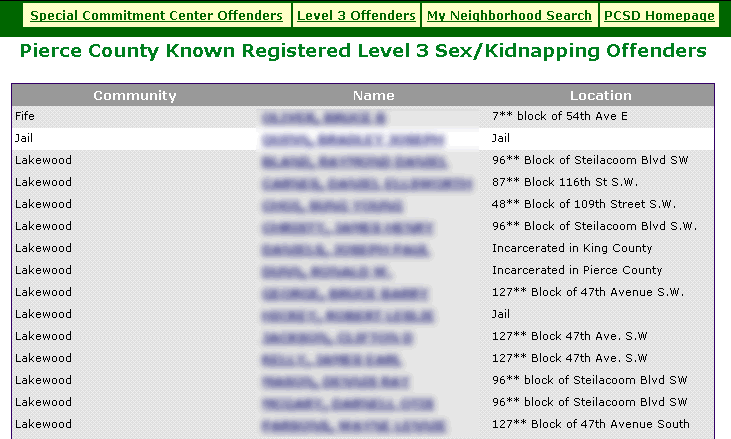
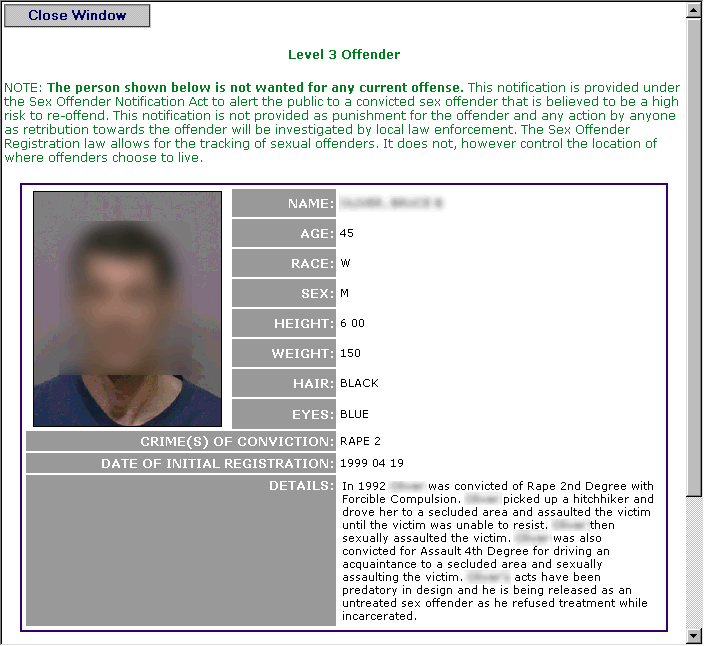
The Public Sex Offender site solved one problem by freeing up Sheriff Personnel from personally answering questions from the public. Instead of calling a deputy, the public visits a web site available 24 hours a day. However, because of the heightened awareness caused by the SO site, the public demanded updated information. The Sex Offender Verification web application was built to help the Sheriff's department maintain the Sex Offender Registry.
The SOV web application contains two modules: verification forms and management reports. SOV is part of the Sheriffs Department's Portal which is a web page that lists links to other departmental applications. The portal allows the deputies to go to on place for all of their applications. The portal also manages security and permissions facilitating rapid application development.
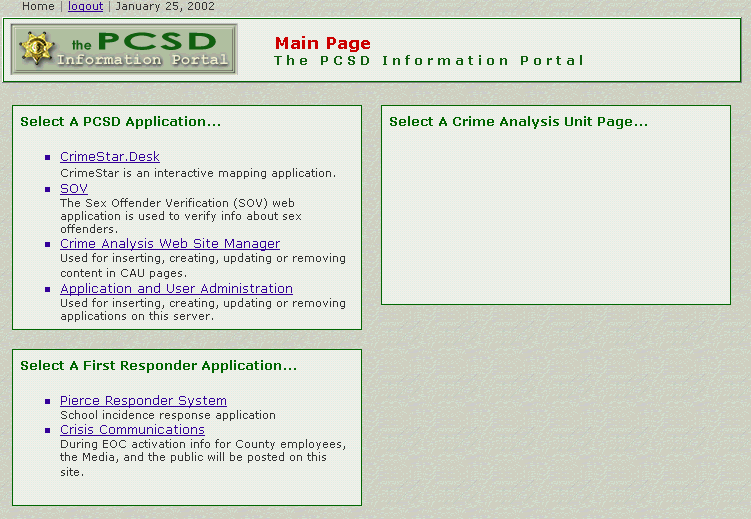
Deputies use wireless Internet technology on lap-top computers to access and use SOV verification forms to collect registration information (name, address, and other pertinent information) from the registered sex offenders. Once collected, this information forms a verification history and is instantly available to everyone with access to the system.
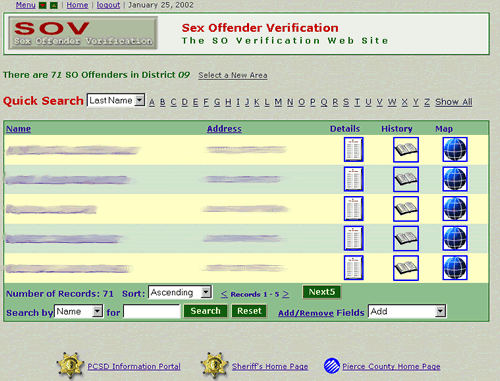
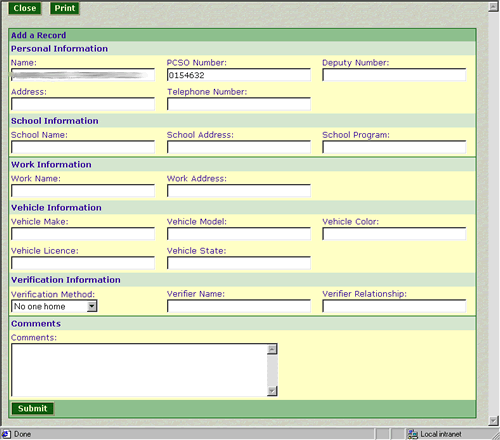
Deputies also have access to the Sheriffs detailed Sex Offender database, dynamic maps, and the entire verification history of any given sex offender. These resources give them the best information in the field where they need it most. SOV uses Esri's ArcIMS technology to provide dynamic maps. Deputies can enter any address and then view sex offender locations with other GIS layers such as schools. These maps show geographic trends that traditional databases can not.
The management report module consists of a series of dynamic charts that allow the Pierce County Sheriff to track the verification process and to identify when a verification is either coming due or overdue. The Verification Report provides a list and chart of the number of sex offenders verified per subject (class or deputy number) or area (district, zip code, or city) for a given date range. The date ranges are divided into a series of frequently used pre-determined categories (This Week, Last Week, This Month, Last Month, etc…). Users can also create their own unique date ranges using an online calendar.
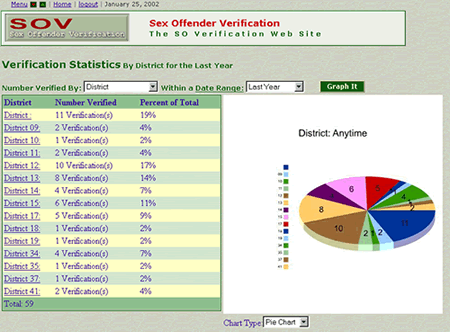
Similarly, the Verification Log provides a simple table of every verification event that users can query. The Sex Offender Registry database used in the public SO site is kept up to date using this page and the information the deputies collect. The Overdue Report allows the Pierce County Sheriff to stay in compliance with State and Federal Laws by either proactively warning them when a sex offender needs registration or is overdue. The Overdue Report Statistics extend this capability allowing deputies to list overdue sex offenders by subject or area and analyze where their valuable resources should be allocated.
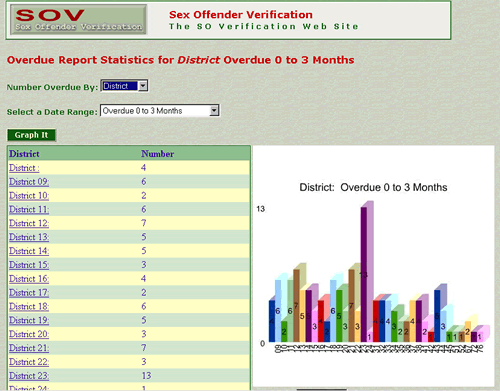
The Public Sex Offender Verification web site and the Sex Offender Verification Web application have enabled the Pierce County Sheriffs department to utilize their limited resources while providing critical public safety information. The Registered Sex/Kidnapping Offender Search site (SO) allows the public to search their neighborhood for registered sex offenders. The Sex Offender Verification (SOV) web application is used by the Pierce County Sheriff department to verify the addresses of convicted sex offenders and to track the progress of this process with a suite of management reports.
Dan King SO Web Site Programmer